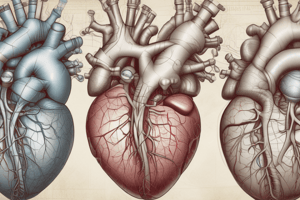Podcast
Questions and Answers
What are the two distinct forms of Pulmonary Hypertension mentioned in the text?
What are the two distinct forms of Pulmonary Hypertension mentioned in the text?
- Acute and Chronic
- Systolic and Diastolic
- Primary and Secondary
- Passive and Reactive (correct)
What can elevated pulmonary venous pressures in Mitral Stenosis lead to?
What can elevated pulmonary venous pressures in Mitral Stenosis lead to?
- Constriction of pulmonary vessels
- Increased systemic blood pressure
- Opening of collateral channels between pulmonary and bronchial veins (correct)
- Decreased left atrial pressure
What is the outcome of chronic pressure overload of the left atrium in Mitral Stenosis?
What is the outcome of chronic pressure overload of the left atrium in Mitral Stenosis?
- Constriction of atrial walls
- Reduction in left atrial pressure
- Stimulation of atrial enlargement (correct)
- Decreased pulmonary resistance
What happens to pulmonary capillaries in Reactive Pulmonary Hypertension?
What happens to pulmonary capillaries in Reactive Pulmonary Hypertension?
What can elevated right-sided cardiac pressures in Reactive Pulmonary Hypertension lead to?
What can elevated right-sided cardiac pressures in Reactive Pulmonary Hypertension lead to?
Flashcards
Forms of Pulmonary Hypertension
Forms of Pulmonary Hypertension
Pulmonary Hypertension exists in two forms, Passive and Reactive.
Mitral Stenosis Collateral Channels
Mitral Stenosis Collateral Channels
In Mitral Stenosis, high pulmonary venous pressures can cause collateral channels to open between pulmonary and bronchial veins.
Chronic pressure overload outcome
Chronic pressure overload outcome
In Mitral Stenosis, chronic pressure overload of the left atrium leads to atrial enlargement.
Reactive Pulmonary Hypertension capillary protection
Reactive Pulmonary Hypertension capillary protection
In Reactive Pulmonary Hypertension, medial hypertrophy and intimal fibrosis protect pulmonary capillaries from excessively high pressures.
Signup and view all the flashcards
Reactive Pulmonary Hypertension blood flow
Reactive Pulmonary Hypertension blood flow
In Reactive Pulmonary Hypertension, increased right-sided cardiac pressures can reduce blood flow through pulmonary circulation.
Signup and view all the flashcards




